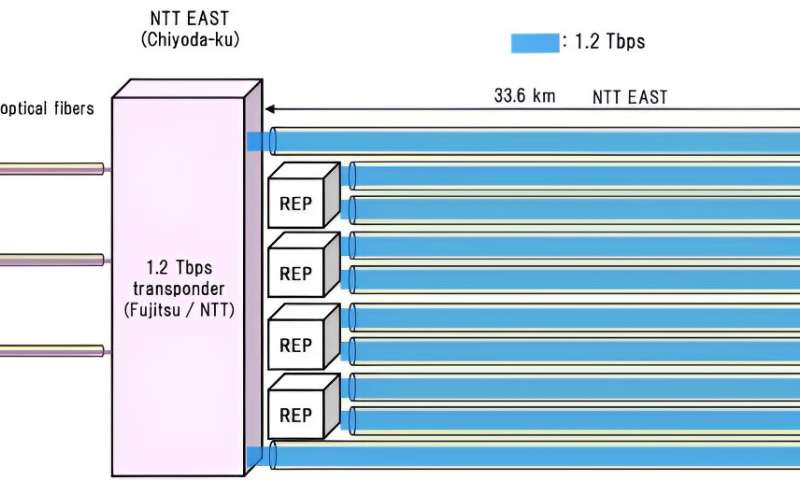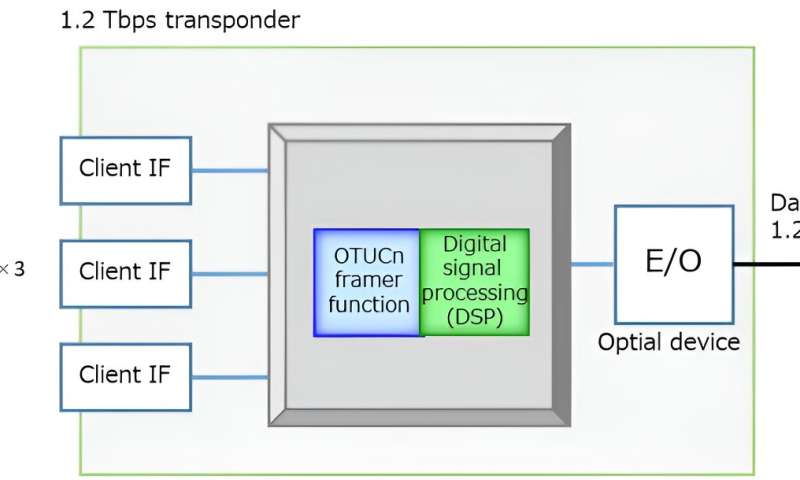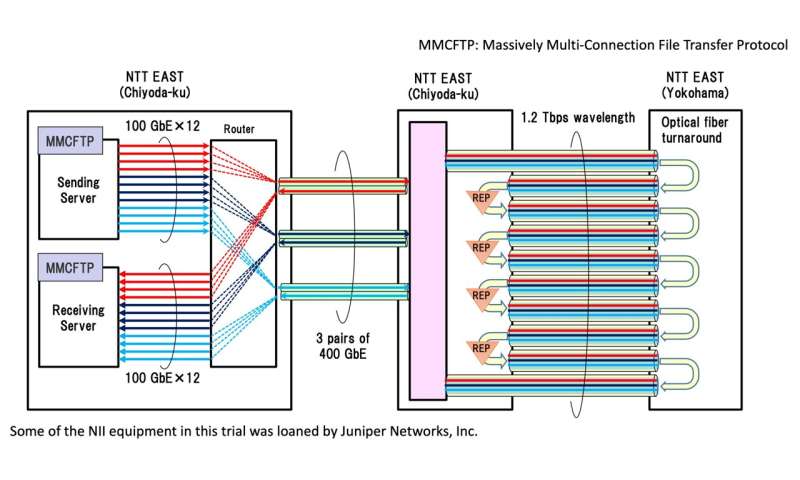Research group achieves a world record of 1.2Tbps for optical signal transmission

A Japanese consortium of joint research partners including the National Institute of Informatics (NII), Nippon Telegraph and Telephone Corporation (NTT), Nippon Telegraph and Telephone East Corporation (NTT EAST), and Fujitsu Limited today announced that they have constructed the world's longest transmission link at 1.2 Tbps per optical wavelength and succeeded in full throughput transmission and the world's largest capacity data transfer over 1 Tbps using a pair of general-purpose 1-socket servers.
This field trial was conducted using NTT EAST's commercial optical fiber, NTT's digital signal processing technology and devices, Fujitsu's next-generation optical transmission system 1FINITY Ultra Optical System, and Massively Multi-Connection File Transfer Protocol (MMCFTP), a file transfer protocol developed by NII.
This achievement opens the door to a variety of high-speed, high-capacity communication services, including academic communication networks, while simultaneously contributing to lower costs and lower power consumption. The research group will use this achievement to further advance academic communication networks and promote research and development toward the realization of the Innovative Optical and Wireless Network (IOWN).
Background
In recent years, communication traffic has increased rapidly due to the development of 5G services, big data, AI, cloud computing, etc., and there is a need to further increase the speed and capacity of communication networks.Since April 2022, for example, NII has been operating SINET6, an academic information network connecting all prefectures in Japan with 400 Gbps lines excluding Okinawa connecting with 200G. SINET6 also connects Japan and the United States with 200 Gbps lines.
However, demand for SINET6 has been rapidly increasing, for example, transferring data is approaching 400 Gbps, and as access lines for universities and research institutions have become faster (currently 15 lines of 400 Gbps, 88 lines of 100 Gbps, 884 lines of 10 Gbps, etc.). Thus, further capacity expansion is desired to reach over 400 Gbps.
At the same time, NTT aims to realize the All-Photonics Network (APN) under the IOWN initiative by around 2030. NTT also aims to increase the transmission capacity by 125 times by introducing photonics-based technology at APN to realize overwhelmingly low power consumption, high quality, high capacity, and low delay transmission that is difficult with current electronics-based technology.

To achieve these goals, NII is working on high-throughput file transfer technology that maximizes the use of high-capacity circuits. Fujitsu and NTT are also developing digital coherent signal processing circuits and photoelectric fusion devices that can deliver the world's largest capacity optical transmission of 1.2 Tbps per optical wavelength, as well as optical transmission systems.
In this field trial, the research group combined the technological development results of each organization and demonstrated the world's longest transmission at 1.2 Tbps per optical wavelength and the data transfer.
Field trials overview
In October 2023, the research group constructed an optical transmission network environment capable of transmitting 1.2 Tbps per optical wavelength between Tokyo and Kanagawa Prefecture in Japan and conducted 2 types of field trials.
The research group constructed a network that starts in Chiyoda-ku, Tokyo and an optical fiber turns around in Yokohama, Kanagawa Prefecture, and confirmed that transmission of 1.2 Tbps per optical wavelength is possible. The full throughput of the 1.2 Tbps signal was verified by a tester for the trial. This is the first time in the world that an optical signal of 1.2 Tbps per optical wavelength has been transmitted over 336 km using commercial optical fiber. The role of each organization in this trial is as follows:
NTT: developed the world's most advanced digital signal processing technology, a chip that implements OTUCn technology capable of multiplexing up to 3 Gigabit Ethernet (400 GbE) chips, and one of the world's largest optical devices with an optical-electrical response band.
Fujitsu: developed a transponder that can achieve a transmission rate of 1.2 Tbps per optical wavelength at 150 Gbaud using a chip developed with Fujitsu and others, led by NTT.
NTT EAST: developed a trial optical network using commercial optical fiber.

The research group transferred data using MMCFTP using NII's a pair of general-purpose 1-socket servers in an environment that transmits 1.2 Tbps . As a result of the trial, a large capacity data of about 47 TBytes was successfully transferred at a data transfer rate of 1,034 Gbps. At a data transfer rate of 1034 Gbps, one Blu-ray disk with a typical capacity of 25 GBytes can be transferred in about 0.2 seconds. 47 TBytes of data is roughly equivalent to that contained in 1,880 Blu-ray discs can be transferred in approximately 376 seconds.
Future Plans
NII is supporting the development of Japanese research and education nationwide through the development of SINET, the world's highest-performance network infrastructure, and will continue to pursue its advantages of both ultra-high speed, high capacity, and low latency. In addition, NII will also provide MMCFTP widely to SINET users to realize efficient data distribution and enhance practicality.
NTT aims to further advance the IOWN APN, which enables overwhelmingly low power consumption, high capacity, and low delay transmission, by developing a large-capacity optical transmission system utilizing these results.
NTT EAST will continue to study the realization of high-speed and large-capacity communication services using large-capacity optical transmission systems.
Fujitsu will continue to develop technologies to increase the capacity and reduce the power consumption of optical transmission systems based on the results of this demonstration and contribute to the realization of a sustainable society together with its customers and partners.
Provided by Research Organization of Information and Systems